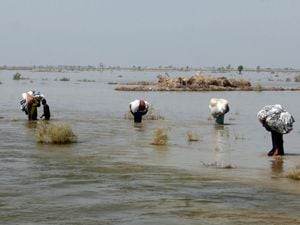‘Fingerprints’ of climate change on devastating Pakistan floods
The flooding this summer comes after record-breaking monsoon rainfall in the south Asian country.

The “fingerprint” of climate change is on the devastating floods in Pakistan, experts said, after analysis found it was likely to have increased the extreme rainfall behind them.
Large areas of Pakistan experienced record-breaking monsoon rainfall from June 2022 in pulses that caused the Indus River to burst its banks over thousands of square kilometres, and led to urban flash floods and landslides.
More than 33 million people have been affected, and 1,500 have died, while homes, roads, health centres and schools have been destroyed or damaged, livestock killed, cropland ruined and there have been outbreaks of disease.
The south Asian country received more than three times its usual rainfall in August, with the two southern provinces Sindh and Balochistan each experiencing their wettest August on record.
More than two dozen scientists from around the world working as part of the World Weather Attribution initiative assessed whether human-caused climate change made the extreme rainfall that caused the floods more likely and intense.

They looked at the 60-day period of heaviest rainfall from June to September across the Indus river basin and the five-day period of heaviest rainfall over the worst-hit provinces of Sindh and Balochistan.
The analysis found that the extreme rainfall was a one-in-a-100-year event in the current climate, which is 1.2C above pre-industrial levels.
Comparison of weather data today with 1.2C of warming and the past showed the five-day maximum rainfall is 75% more intense, while the 60-day rainfall is 50% more intense, meaning this level of heavy rainfall is more likely to happen.
But the scientists said the high variability in rainfall from year to year in the region made the estimates uncertain, and analysis of climate computer models with and without human-caused global warming could not accurately quantify the overall role of climate change.
However, for the five-day rainfall extreme, the majority of models and observations analysed show that intense rain has become heavier as Pakistan has warmed.
Some models suggest that climate change increased the five-day rainfall total by up to 50%, in line with global climate science assessments which project more intense rains in the region, the researchers said.
And if the climate warms to 2C above pre-industrial levels, computer models suggest five-day pulses of heavy rain will become significantly more intense, the scientists said.
They also warned that while some level of impacts from the extreme rain and floods were likely to have been unavoidable, many factors increased the damage, including poverty and political instability in Pakistan.
The extreme rain and floods come after unusually high temperatures in spring in Pakistan, with temperatures climbing above 50C in some places.
Heatwaves have also become more frequent, likely and intense as a result of climate change.
Fahad Saeed, researcher at the Centre for Climate Change and Sustainable Development, in Islamabad, Pakistan, said: “Fingerprints of climate change in exacerbating the heatwave earlier this year, and now the flooding, provide conclusive evidence of Pakistan’s vulnerability to such extremes.”
He said Pakistan must push the world to reduce emissions immediately at the forthcoming UN Cop27 climate talks in Egypt, and ask developed countries to provide support to help countries and people bearing the brunt of climate change.
Friederike Otto, senior lecturer in climate science at the Grantham Institute – Climate Change And The Environment, Imperial College London, said: “Our evidence suggests that climate change played an important role in the event, although our analysis doesn’t allow us to quantify how big the role was.”
She said the very variable weather from year to year in the region made it hard to see long-term changes in observed data and climate models.
But she said: “What we saw in Pakistan is exactly what climate projections have been predicting for years.
“It’s also in line with historical records showing that heavy rainfall has dramatically increased in the region since humans started emitting large amounts of greenhouse gases into the atmosphere.
“And our own analysis also shows clearly that further warming will make these heavy rainfall episodes even more intense.
“So while it is hard to put a precise figure to the contribution of climate change, the fingerprints of global warming are evident.”





